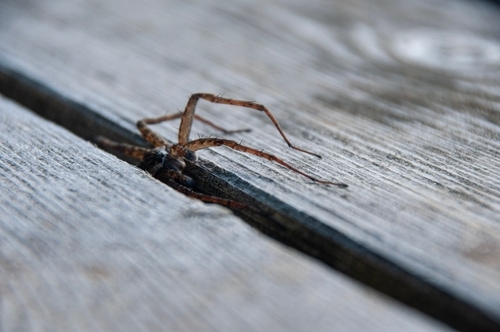The dock spider, a member of the genus Dolomedes, is found primarily in wet environments. In Canada, dock spiders are commonly seen in and near lakeside homes, cabins, and cottages. Dock spiders, sometimes known as wharf spiders, can be readily mistaken for the much more dangerous and poisonous wolf spiders. Despite their undeserved bad reputation, dock spiders are fascinating creatures that pose no threat to humans.
During the mating season, they can be seen on a wide variety of surfaces, from docks and boats to boat houses and even rocks. They’ve adapted through millions of years to a semi-aquatic lifestyle, and they don’t spin webs to catch their prey. Let’s explore these interesting creatures further!
How To Identify A Dock Spider

Dock spiders are large enough to draw attention to themselves.
©OliverGraphics.ca/Shutterstock.com
Given their size, these hairy spiders are easy to notice. They’ll appear out of nowhere at the docks, on your towel, or in the water. They have two rows of four eyes, for a total of eight. Their bodies are a brownish gray, and their legs feature a pattern of bright and dark rings. The undersides of their bodies are also marked in brown. Because of their similarities, dock spiders are frequently misidentified as the native North American striped fishing spider or scriptus.
Dock Spider Size
Dock spiders are relatively large, therefore their size can be used to distinguish them from other types of spiders. They can reach a maximum size of about 100 mm (about 4 inches), making them Canada’s largest species. The size of your palm, these spiders have long legs and a pair of fangs. Female dock spiders are roughly twice as large as males, yet male dock spiders outnumber females by a factor of three. The large dock spider you’ve seen is most certainly a female.
What Kind Of Spider Are They
The enormous dock spiders known as Dolomedes belong to the Pisauridae family. Raft spiders, dock spiders, and wharf spiders are all names for this species. The Dolomedes genus consists entirely of semiaquatic species. Because of the waxy hair covering its entire body, a dock spider can run on water without sinking.
Why Are They So Big
Dock spiders do not use webs to trap their prey. Instead of a web, they use still water to catch prey. To detect moving prey or a fallen insect, a dock spider may extend its front legs on the water and feel for vibrations. The hair plays a crucial function in picking up on these minute vibrations, and the eyes aid in the tracking down of the prey. Insects, tadpoles, and juvenile fish are among their favorite meals. A dock spider bite is toxic enough to injure smaller organisms, so they will chase their meal immediately.
They Only Spin Webs To Protect Their Young

The silk spun by dock spiders is used exclusively for making egg sacs.
©valleyboi63/Shutterstock.com
The silk produced by dock spiders is only ever used for one thing: the production of egg sacs. A single egg sac has the potential to give birth to as many as one thousand spiderlings. The egg sac is carried in the mother spider’s mouth like a huge cotton ball. She spins a new web just as her eggs are about to hatch in order to protect her young from any potential danger.
Do They Bite And Are They Poisonous?
Fortunately, dock spiders never bite. Small fish and aquatic insects make up the bulk of their diet. When these spiders feel threatened or accidentally creep under someone’s clothing, they may bite. Although dock spiders are harmless to humans, they can nevertheless inject their venom if they get close enough. The venom isn’t very potent, so it won’t numb your skin.
How To Control A Dock Spider Infestation

Insecticides around docks or other dock spider hotspots can permanently eliminate them.
©Matt LaVigne/Shutterstock.com
You’ve discovered a dock spider, but you don’t know where it came from. In any case, it’s best to have pest control come out and remove the spider before it finds a hiding place or starts making itself at home.
Some of these measures can be implemented to reduce the likelihood of dock spiders invading your boat or home.
- By routinely washing the docks, you can keep spiders from hunting for meals under the wood and, in turn, keep insects at bay.
- Spraying insecticide near docks or other areas where dock spiders have been seen is an effective approach to drive them away for good.
- You may prevent dock spiders from entering your yacht by spraying bleach around the openings.
- Putting out traps can help prevent these spiders from spreading to new areas as well.
Dealing with a problem involving huge spiders is risky. These spiders may come indoors in search of food or to hibernate for the winter. Close contact with spiders could be dangerous if you don’t know anything about their kind. With kids around, it’s important to be on the lookout for spiders in the backyard and around the pool. If you see any spiders in your home or on your docks, it’s probably in your best interest to get in touch with your local pest control.
The photo featured at the top of this post is © iStock.com/Jordon Sharp
Thank you for reading! Have some feedback for us? Contact the AZ Animals editorial team.






